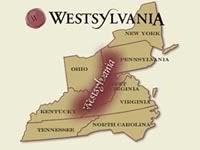
(image from Wikipedia)
It's time to take a break from the spooky and delve into the history of the region. The legendary state of Pittsylvania, sometimes called Westsylvania, was just a Congressional vote away from becoming a reality back in the day.
According to historian George Swetnam, "In March, 1759, less than half a year after Forbes had taken Fort Duquesne and named it Pittsburgh, a letter from New Jersey to the Maryland Gazette reported a movement for application to the Crown . . . 'to settle a New Colony on the Ohio, by the name Pittsylvania.'" It was to include southwestern Pennsylvania, the western panhandle of Maryland, nearly all of what is now West Virginia, a bit of Virginia, and a tad of eastern Kentucky.
The king nixed that petition (we'd get even with him later), but the settlers didn't give up. They were the western frontier then, and believed that their interests were being snubbed by the city fops back East. A writ for the creation of an independent Pittsylvania was presented to the Second Continental Congress in 1775. But the Revolutionary War broke out shortly afterwards, and in the name of national unity, Congress chose to ignore their request, much the same as they do with citizen requests today.
The region's last hurrah at independence was the Whiskey Rebellion. Riled by a tax on whiskey in 1791 by the U.S. government, farmers in the west began making life sheer hell for the federal revenuers. The tax eliminated any profit by the farmers from the sale of a popular & potable cash crop, and it became the lightning rod for a laundry list of grievances by the locals against the federal government. Does "taxation without representation" ring a bell? As a result, much rioting and tar & feathering of federal agents ensued.
The insurrection flared into open rebellion in July of 1794 when a federal marshal was attacked in Allegheny County. At the same time, several hundred men marched on the home of the fed's top tax man and burned it to the ground, along with anything else flammable they could find to torch on his property.
A month later, President George Washington had enough. He called out the militia (there weren't Pinkertons in those days, we guess) and ordered the Western rabble back to their homes. Washington marched at the head of an army of 13,000, although the generaling was left to Harry Lee. They scattered the rebels, squelched the rebellion, saved the union, and killed the last hope of a Pittsylvanian state.
George Swetnam covers the history of the area in his book "Pittsylvania Country".

No comments:
Post a Comment